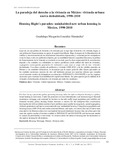
Please use this identifier to cite or link to this item:
http://ricaxcan.uaz.edu.mx/jspui/handle/20.500.11845/489Full metadata record
| DC Field | Value | Language |
|---|---|---|
| dc.contributor | 90730 | es_ES |
| dc.coverage.spatial | México | es_ES |
| dc.creator | González Hernández, Guadalupe Margarita | |
| dc.date.accessioned | 2018-02-27T20:25:55Z | |
| dc.date.available | 2018-02-27T20:25:55Z | |
| dc.date.issued | 2013-01-01 | |
| dc.identifier | info:eu-repo/semantics/publishedVersion | es_ES |
| dc.identifier.issn | e-ISSN: 1679-0383 | es_ES |
| dc.identifier.uri | http://hdl.handle.net/20.500.11845/489 | |
| dc.description | Far from being a promotion policy governing housing under the right to adequate housing is a policybased lending to real estate. Under the protection of credit liberalization and restructuring of financial institutions mortgage, and sustained by workers as the only really target population, job stability and financial security, policy housing finance becomes a success for the enterprise-class construction, leaving the city with an infinite number of new problems (poor quality housing stock, spatial segregation, violence generation) and here is concerned only one: uninhabited housing. Using data on population and housing census (1990-2010) and credits exercised Mexico and states, it is shown that most of them were executed in the Mexican cities over one hundred thousand inhabitants because they are urban spots that meet the captive market of workers entitled to INFONAVIT and FOVISSSTE and the income needed to sustain the profitability of real estate. No concern about the utility of housing and the declaration of the right to housing for all residents. | es_ES |
| dc.description.abstract | Lejos de ser una política de fomento a la vivienda que se rige bajo el derecho a la vivienda digna, es una política de financiamiento en apoyo al capital inmobiliario. Bajo el amparo de la liberalización de créditos y reestructuración de las instituciones financieras hipotecarias, y sostenida por los trabajadores como la única realmente población objetivo, por su estabilidad laboral y seguridad financiera, la política de financiamiento de la vivienda se convierte en un éxito para la clase empresarial de la construcción, dejando a las ciudades con infinidades de nuevos problemas (mala calidad del stock de viviendas, segregación socioespacial, generación de violencias) y que aquí se ocupa sólo de uno: viviendas deshabitadas. Con datos censales de población y vivienda (1990-2010) y de los créditos ejercidos en México y sus entidades federativas, se demuestra que la mayor parte de ellos fueron ejecutados en las ciudades mexicanas mayores de cien mil habitantes porque son manchas urbanas que cumplen con el mercado cautivo de trabajadores con derecho a INFONAVIT y FOVISSSTE y con los ingresos necesarios para sustentar la rentabilidad del capital inmobiliario. Sin preocupación por la utilidad de la vivienda y la declaración al derecho a la vivienda por todos los residentes. | es_ES |
| dc.language.iso | spa | es_ES |
| dc.publisher | Universidade Estadual de Londrina | es_ES |
| dc.relation | http://www.uel.br/revistas/uel/index.php/seminasoc/article/view/14967 | es_ES |
| dc.relation.ispartof | http://www.uel.br/revistas/uel/index.php/seminasoc/index | es_ES |
| dc.relation.uri | generalPublic | es_ES |
| dc.rights | Attribution-NonCommercial-ShareAlike 3.0 United States | * |
| dc.rights.uri | http://creativecommons.org/licenses/by-nc-sa/3.0/us/ | * |
| dc.source | Semina: Ciencias Sociais e Humanas, Londrina, vol. 34, no. 1, pp. 53-68. | es_ES |
| dc.subject.classification | CIENCIAS SOCIALES [5] | es_ES |
| dc.subject.other | Vivienda | es_ES |
| dc.subject.other | Crédito hipotecario | es_ES |
| dc.subject.other | Ciudades mexicanas. | es_ES |
| dc.subject.other | Housing | es_ES |
| dc.subject.other | Mortgage | es_ES |
| dc.subject.other | Mexican cities | es_ES |
| dc.title | La paradoja del derecho a la vivienda en México: vivienda urbana nueva deshabitada, 1990-2010 | es_ES |
| dc.title.alternative | Housing Right´s paradox: uninhabited new urban housing in Mexico, 1990-2010 | es_ES |
| dc.type | info:eu-repo/semantics/article | es_ES |
| Appears in Collections: | *Documentos Académicos*-- UA Estudios del Desarrollo | |
Files in This Item:
| File | Description | Size | Format | |
|---|---|---|---|---|
| La paradoja del derecho a la vivienda en México.pdf | 390,92 kB | Adobe PDF |  View/Open |
This item is licensed under a Creative Commons License
